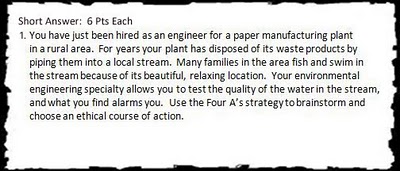Stronger than multiple choice, yet not quite as revealing (or time consuming to grade) as the essay question, the short answer question offers a great middle ground – the chance to measure a student’s brief composition of facts, concepts, and attitudes in a paragraph or less.
Read more ›CURRENT ARTICLE • January 12
OTHER RECENT ARTICLES
Staring at a blank screen the night before the research paper was due—this was the dilemma faced by my upper-level science students. The paper, the product of their independent research projects, is an important part of our curriculum and one component of our assessment of their scientific writing skills.
Read More ›Aristotle was wrong. He thought that knowledge was passed from person to person like water is transferred between vessels. Aristotle believed in education through reading great texts and listening to great teachers, with the knowledge filling the learner’s mind.
Read More ›The Teaching Professor Blog is now located on Magna’s Faculty Focus website. We are happy to be here and happy to be welcoming new readers. As our regular readers know, this blog contains a variety of content. It may highlight findings from a study, describe an instructional strategy, raise issues and concerns, or comments on solutions. It regularly offers advice, aspiring to propose ways and means that enhance learning. And sometimes the message is inspiration. Teaching isn’t always easy and learning can seem very elusive.
Read More ›We've all used them, first as students and now as online instructors: activities in a class meant to highlight, spotlight, underline, enhance, or explain some aspect of the subject we are teaching. Too often, not much thought or effort is given to these activities, resulting in outdated and unsuccessful activities. With the right approaches and a bit of knowledge, online instructors can create activities that are dynamic, effective, and interesting.
Read More ›Blended learning — a strategy that combines online and classroom learning activities and resources to reduce in-class seat time for students in a face-to-face environment — can be a tremendous boon for a university. It can help the institution enhance under-enrolled programs, complete faculty teaching loads, and improve cost effectiveness. However, convincing the institution’s constituents that a blended course or program is a good idea may take some work.
Read More ›There are three main legal issues that can cause trouble in online educational programs: ownership issues, copyright issues, and issues of harassment and defamation. Each of these issues also pertains to the face-to-face classroom setting but requires a fresh perspective when applied to distance education.
Read More ›One of the student engagement techniques described in Elizabeth F. Barkley’s Student Engagement Techniques: A Handbook for College Faculty has students predicting and reflecting on their exam preparation and performance. It’s a technique that helps students see the correlation between their efforts and their exam scores, as well as one that helps them assess the effectiveness of the study strategies they use.
Read More ›A Vision of Students Today is a short video created by Michael Wesch, associate professor of cultural anthropology at Kansas State University, and 200 KSU students.
Read More ›Social media has allowed anyone to become a video producer. The result is an explosion of high-quality teaching videos. Thirty years ago a teacher might show a PBS video in class every once in a while, mostly just as a break from the usual routine. But today there are thousands of videos from which to choose.
Read More ›






